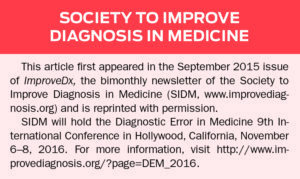Health IT and Diagnostic Safety: Promise and Peril
By Susan Carr
When it comes to information technology (IT), clinicians and hospitals might advise, “Be careful what you wish for.” Embraced as the answer to many of healthcare’s safety problems, technology provides useful tools that may improve but in no way guarantee safety. In fact, health IT can introduce as well as prevent or catch errors and must be designed, implemented, and monitored carefully, like any other tool used in patient care (Committee on Patient Safety, 2012).
Electronic health records (EHR), in particular, are caught between high expectations for delivering safer, more efficient care and frustration based on poor performance. Clinicians complain that electronic records slow them down and make their work more difficult (Friedberg et al., 2013). Patients who access their records often do so out of self-defense, concerned that they may be harmed by incorrect information in the EHR (Dullabh, Sondheimer, Katsh, & Evans, 2014).
Healthcare providers and consumers will eventually reap the full benefit of electronic records, but many view current EHR systems as a disappointment. In The Digital Doctor, Robert Wachter (2015) observes that some consumer electronics, such as Apple’s iPhone®, breeze through the Gartner Hype Cycle (n.d.), sliding easily from the “peak of inflated expectations” to the “slope of enlightenment” and “plateau of productivity,” wasting little time in the “trough of disillusionment” (p. 247), where healthcare technology seems to be stuck.
Efforts to use health IT to improve diagnosis are not immune to this double-edged effect of benefit and risk. In 2010, Gordon Schiff and David Bates examined the promise and peril of electronic documentation in the context of diagnostic safety. Describing 15 ways that electronic documentation can improve diagnosis, they also identify hazards and challenges. They look forward to the day when the diagnostic process becomes less “heroic” (p. 1066) and more reliable because physicians are supported with good information supplied in ways that are supportive and compatible with clinical workflows.
Divided attention
Data and information are crucial to diagnosis, but how they are presented and what the IT system demands of the user may determine whether they help or hinder the process. In addition to increasing risk by causing errors or supplying incorrect information, technology can also degrade the cognitive process by  distracting physicians—essentially competing with the patient for a physician’s attention—and adding irritation and delay.
distracting physicians—essentially competing with the patient for a physician’s attention—and adding irritation and delay.
Reporting on a healthcare design conference held in Boston in 2015, Andy Oram observes that healthcare technology poses a challenge that designers don’t usually face when writing software or apps for other industries. In patient care settings, technology often does not (must not) have the user’s full attention. The clinician “must alternate constantly between interacting with the software and interacting with a living human being…. The app must not only be unobtrusive, but must support the clinician’s interaction with the patient.”
